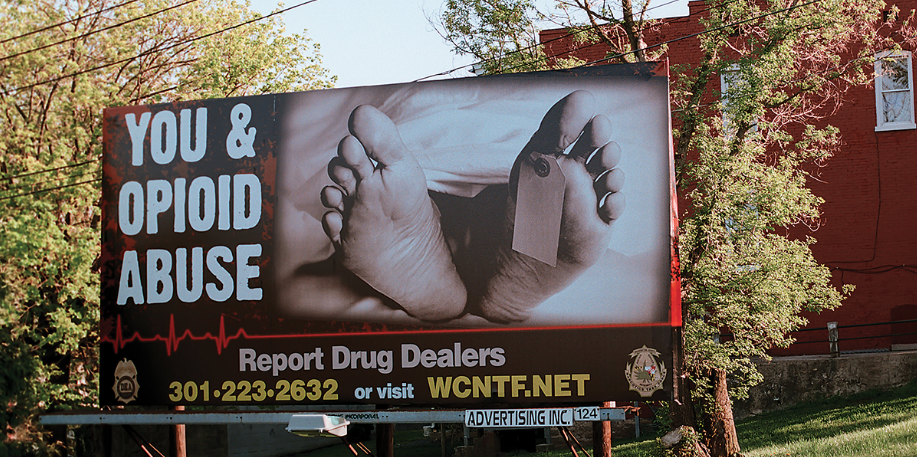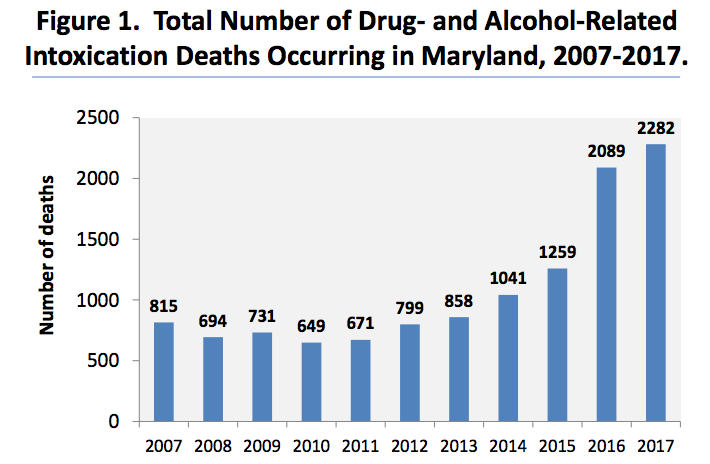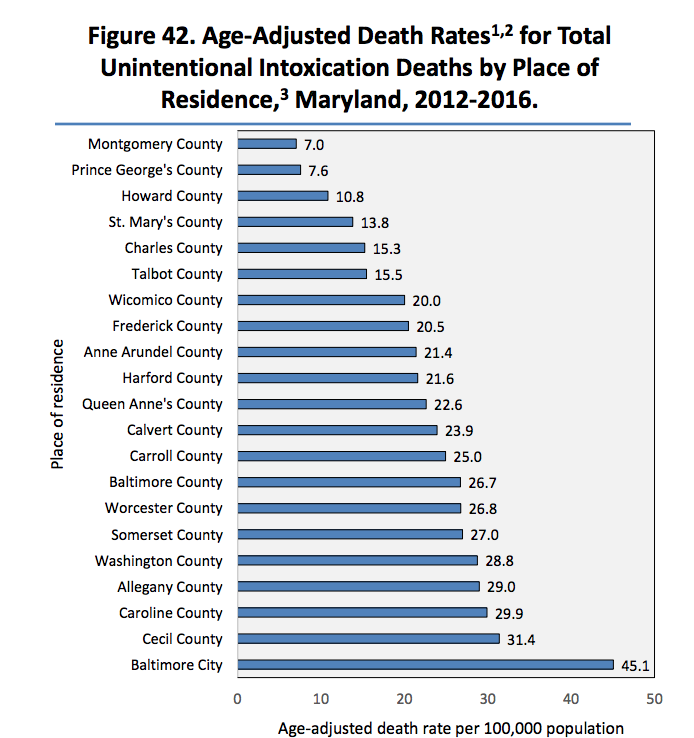
More than 2,200 Maryland residents died in 2017 from unintended drug and alcohol-related intoxication, setting an all-time mark for the state in the seventh consecutive year.
Of 2,282 drug and alcohol-related deaths in Maryland last year, 2,009 were opioid-related, according to a report released Thursday by the Maryland Department of Health. Those numbers have more than tripled since 2011, when the number of opioid-related deaths in the state first began to rise. The statewide data from the first quarter of 2018—which shows a nearly 20 percent increase in unintended intoxication deaths over the same period last year—indicates the ongoing public health crisis is only worsening.
Baltimore magazine chronicled the opioid crisis and its impact on Hagerstown and Washington County in our July issue.
In Baltimore City, 761 people died from drug and alcohol related deaths in 2017, a significant increase from the 694 fatalities in 2016—and a seven-fold jump since 2011—driven by opioid-related overdoses. Baltimore is one of hundreds of jurisdictions in the U.S. that has sued pharmaceutical manufacturers and distributors of opioids for their alleged criminal roles in bringing the drugs to market.
Baltimore City, by far, has the highest death rate for unintentional intoxications deaths in the state at 45.1 deaths per 100,000 residents. It is followed by Cecil County (31.4), Caroline County (31.4), Caroline County (29.9), Allegany County (29.0) and Washington County (28.8).
“We are seeing an epidemic of overdoses in Maryland and around the country and these numbers are terrifying,” said Baltimore Health Commissioner Dr. Leana Wen in response to the report. “We are not even at the peak of the epidemic and we don’t know what the peak looks like.”

Fentanyl, a powerful opioid painkiller, which is also made illegally and sometimes mixed with cocaine and heroin, continues to be one of the factors driving overdose fatalities.
“In the first three months of 2018 alone, we’ve seen 500 fentanyl-related deaths,” Maryland Department of Health Secretary Robert R. Neall said in a statement. “We’re asking those with a substance use disorder to immediately seek treatment and for more individuals to learn how to use and carry naloxone.”
Wen said the city needs more resources to combat the crisis, including additional funding to make naloxone, a medication that can be used by non-medical professional citizens to rapidly reverse an overdose, more available. “Everyday residents in Baltimore saved 1,130 people in 2017, but we are rationing its use,” Wen said. “Imagine how many more lives we could save if we had the money to do so.”
Wen added that the city also needs greater state and federal support to help treat those with addiction issues. “Treatment is not a one-off,” she said. “It needs to be sustained to be effective.”
The new numbers and report quickly became campaign fodder in the current race for governor between incumbent Republican Larry Hogan and Democratic nominee Ben Jealous.
“The opioid epidemic is one of the most challenging public health crises of our time and it is clear that Larry Hogan’s incremental steps are not getting the job done,” said Maryland Democratic Party spokesperson Fabion Seaton in a statement. “Ben Jealous has proposed a bold and innovative plan to take the opioid epidemic head-on, but Gov. Hogan shouldn’t wait to implement these solutions, he should implement them now. Lives are at stake and time is of the essence.”
The state Health Department called tacking the opioid epidemic “a top priority” of the Hogan-Rutherford Administration in a press release accompanying the report.
“Every day, numerous state agencies and other stakeholders are working together on the statewide response. We are seeing success on the prescriber side as hospitals and medical providers have been driving innovative solutions to reduce inappropriate prescribing,” said Clay Stamp, executive director, the state’s Opioid Operational Command Center. “Yet, we have to stay focused on and resolute in our three-pronged strategy – prevention and education, enforcement, and expanding access to treatment and recovery.”
On Friday, U.S. Rep. Elijah Cummings (D-MD) and U.S. Sen. Elizabeth Warren (D-MA) will hold a roundtable discussion with Baltimore community leaders on efforts to combat the epidemic. Earlier this year, Cummings and Warren introduced the Comprehensive Addiction Resources Emergency (CARE) Act, which is modeled on the Ryan White Comprehensive AIDS Resources Emergency Act. That act was enacted nearly three decades years ago with bipartisan support to boost federal investments and local decision-making to stem the HIV/AIDS epidemic.

